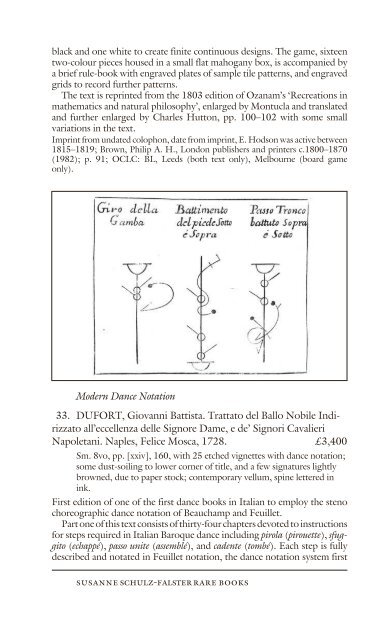Susanne Schulz-Falster Catalogue Eighteen - International League ...
Susanne Schulz-Falster Catalogue Eighteen - International League ...
Susanne Schulz-Falster Catalogue Eighteen - International League ...
You also want an ePaper? Increase the reach of your titles
YUMPU automatically turns print PDFs into web optimized ePapers that Google loves.
lack and one white to create finite continuous designs. The game, sixteen<br />
two-colour pieces housed in a small flat mahogany box, is accompanied by<br />
a brief rule-book with engraved plates of sample tile patterns, and engraved<br />
grids to record further patterns.<br />
The text is reprinted from the 1803 edition of Ozanam’s ‘Recreations in<br />
mathematics and natural philosophy’, enlarged by Montucla and translated<br />
and further enlarged by Charles Hutton, pp. 100–102 with some small<br />
variations in the text.<br />
Imprint from undated colophon, date from imprint, E. Hodson was active between<br />
1815–1819; Brown, Philip A. H., London publishers and printers c.1800–1870<br />
(1982); p. 91; OCLC: BL, Leeds (both text only), Melbourne (board game<br />
only).<br />
Modern Dance Notation<br />
33. DUFORT, Giovanni Battista. Trattato del Ballo Nobile Indirizzato<br />
all’eccellenza delle Signore Dame, e de’ Signori Cavalieri<br />
Napoletani. Naples, Felice Mosca, 1728. £3,400<br />
Sm. 8vo, pp. [xxiv], 160, with 25 etched vignettes with dance notation;<br />
some dust-soiling to lower corner of title, and a few signatures lightly<br />
browned, due to paper stock; contemporary vellum, spine lettered in<br />
ink.<br />
First edition of one of the first dance books in Italian to employ the steno<br />
choreographic dance notation of Beauchamp and Feuillet.<br />
Part one of this text consists of thirty-four chapters devoted to instructions<br />
for steps required in Italian Baroque dance including pirola (pirouette), sfuggito<br />
(echappé), passo unite (assemblé), and cadente (tombé). Each step is fully<br />
described and notated in Feuillet notation, the dance notation system first<br />
susanne schulz-falster rare books catalogue eighteen<br />
published by French choreographer Raoul-Auger Feuillet in 1700. The<br />
second part of the manual contains detailed instructions for contredans,<br />
galliards, sarabands, rigodouns, etc., and a separate chapter on the minuet.<br />
Also included is a brief history of dancing at the French court, and a<br />
discussion of theatrical dances of the time.<br />
Cole Collection 167; Derra de Moroda 833: ‘An important book on the dance<br />
of the time, giving the names of the steps in French and Italian, and very good<br />
descriptions’; Fletcher, Rare Dance Books, 29; Magriel, p. 97; Sowell 49.<br />
The Physiocrats’ Manifesto<br />
34. [DUPONT DE NEMOURS, Pierre Samuel.] De l’Origine et<br />
des Progrès d’une Science nouvelle. London, Paris, Desaint, 1768.<br />
[bound after:] [PECHMEJA, Jean de.] Eloge de Jean-Baptiste<br />
Colbert. Discours, Paris, J.B. Brunet, 1773. £5,500<br />
8vo, pp. [iv], 84, title vignette and head-piece, with B1 uncancelled and<br />
no errata; some light browning due to paper quality; 52; contemporary<br />
green vellum, sides with triple gilt rule and arms to upper and lower<br />
board, spine decoratively gilt, gilt -lettered spine label, paper shelf mark<br />
to head of spine; short split to foot of upper joint; with somewhat later<br />
bookplate of Jean Wallon to front paste-down.<br />
First edition, very rare first issue of the book edition of Dupont de Nemours’<br />
famous analysis and epitome of the Physiocratic doctrine. De l’Origine had<br />
a two-fold purpose: to describe the origin of physiocratic doctrine and to<br />
restate in popular language the theoretical synthesis of Quesnay’s ideas<br />
constructed by Mercier. In this eighty-four-page work Dupont de Nemours<br />
presented the clearest explanation of the origins, philosophy, economics, and<br />
politics of the physiocratic doctrine and the nature of society envisioned by<br />
the physiocrats, in terms that were easy to understand. Quesnay may have<br />
invented physiocracy, and Mercier may have systematized it; but Dupont<br />
de Nemours clarified its theory and interpreted it in a manner capable of<br />
being understood by the general literate public (see James. J. McLain, The<br />
Economic Writings of Du Pont de Nemours, pp. 86–89). Dupont’s account<br />
can be seen in many ways as the apogee of the Physiocratic movement,<br />
with this small book as the pinnacle of their achievement, it was published<br />
simultaneously in volume III of the Physiocratie.<br />
This is the very rare first issue with B1 uncancelled, different from most<br />
copies extant (including the Kress copy) which have it cancelled. In his<br />
uncancelled B1 Dupont de Nemours comments with a somewhat ironical<br />
tone on the Journal d’Agriculture, du Commerce et des Finance, after he had<br />
been ousted as editor: ‘On prétend qu’il dure encore’ – assuming that it<br />
still exists – as if it was likely to have folded under the new editor. This was<br />
apparently too much for the censors, who forced Dupont de Nemours to<br />
cancel leaf B1 and tone down his comment on the replacement leaf.<br />
Dupont de Nemours had been director of the Journal d’Agriculture, du<br />
Commerce et des Finance and had used it for pro-physiocratic propaganda
















